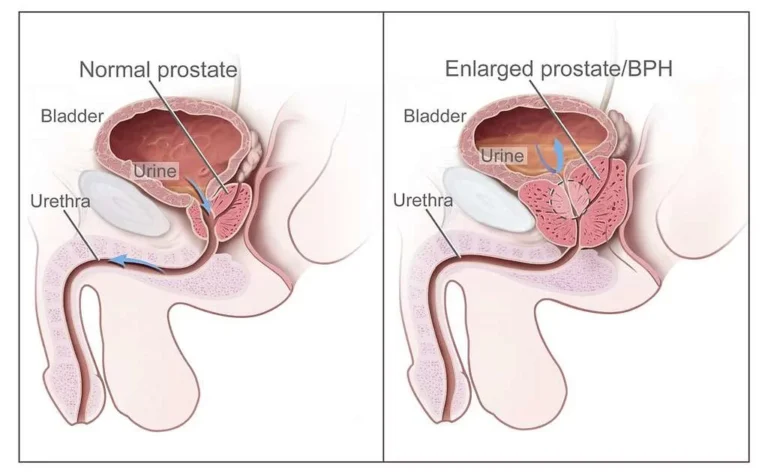A major area of activity in the field of urology focuses on the prostate. The prostate gland is a male accessory sex organ comprised of 30-50 branched glands, weighs about 20 grams and measures 4 x 2 x 3 centimeters (about the size of a walnut). It is surrounded by a fibroelastic capsule that penetrates the gland to divide it into lobes. The capsule and the stroma within the gland contain smooth muscle cells capable of contracting to expell the prostatic fluid. The prostate lies in front of the rectum just under the bladder and surrounds a portion of the urethra. Ejaculatory ducts join the urethra within the prostate gland. The prostate produces an alkaline fluid rich in citric acid, spermine, cholesterol, phosphlipids, fibrinogenase, fibrinolysin, zinc and acid phosphatase, and other proteins. It contributes about 30% of the total seminal fluid volume.
The central zone of the prostate contains pseudostratified epithelium. The peripheral zone is made of stratified epithelium, occupies some 70% of the gland’s volume and is the most prevalent site of prostatic cancer. A transitional zone between the two is the most common site of benign prostatic hyperplasia. The prostate remains normal size until the age of 40-50 when, in some men, in association with decreasing testosterone, it degenerates without any symptoms.
Prostatitis
Infection of the prostate gland may occur from the spread of a bladder or urethral infection. It may also be a result of systemic bacterial spread through blood or lymph. Symptoms of acute bacterial prostatitis are chills, fever, painful or difficult urination, blood in the urine, urinary frequency and urgency. There may also be a urethral discharge and pain in the general area. Adequate treatment will generally clear the bacterial infection. Analgesics, antibiotics, and sitz baths usually yield good results. Chronic infection may result if treatment is not fully successful.
Prostatitis absent of a bacterial infection also occurs. Symptoms are usually mild and include low back pain, urinary frequency, urinary urgency and rectal, urethral or perineal discomfort. This most common type of prostatitis may have some relation to excessive caffeine or alcohol intake.
Benign prostatic hypertrophy
A noncancerous enlargement of the prostate is present in 50% of men more than 50 years of age and in 95% of men more than 70 years of age. It leads to obstruction of the urethra with clinical symptoms in only 5-10% of cases. Symptoms are similar to those of prostatic cancer; difficulty in urination, smaller stream, frequent and less forceful urination.
Testosterone or dihydrotestosterone, in combination with estradiol, has been implicated in the extensive and uncontrolled division of prostate cells seen in benign prostatic hypertrophy. The usual treatment is surgical removal of enlarged tissues. Conservative treatments may include prostatic massage, hot sitz baths, chemotherapy, catheterization and urethral dilation.
Prostate Cancer
Prostatic cancer is the second most common form of cancer in men and the third leading cause of cancer deaths. About 150,000 new cases of prostatic cancer are diagnosed and 40-50,000 men die each year in the US. This desease usually strikes men in their 60’s and 70’s. Racial and geographic differences exist. For example, American blacks have a much higher incidence than Nigerian blacks and Japanese-Americans in Hawaii have an incidence rate between the low rate seen in Japan and the higher rates seen in US caucasians. Risk factors include; a familial history, African-American heritage, American diet (possibly due to low fiber, high fat), and age 50 or above.
The rectal exam should be preformed annually for all men over the age of 40. As most tumors arise in the posterior portion of the prostate the hard nodular masses are easily palpable. Early prostatic cancer is asymptomatic and metastasis to the lung, bone, lymph nodes and liver are common. Early symptoms are those of urethral obstruction. The rectal exam, PSA test, and ultrasound are the best methods to detect prostate cancer.
One half to three fourths of patients will benefit from treatment. Prostate cancer is most successfully treated when detected early. Treatment is dependent on the stage of the disease, the patient’s age, and symptoms. Radiation therapy, radioactive prostate seeds (inplants), cryosurgery, radical prostatectomy, transurethral resection, orchiectomy (castration), chemotherapy, or hormone therapy are possible treatment modalities.
Because prostatic cancer is a testosterone-responsive tissue, lowering serum testosterone is often an effective treatment. Castration and/or oral DES reduce androgen levels, and both options produce a response for about 15 months. Andogenic antagonists such as cyproterone or flutamide are potent agents in previously untreated patients. GnRH analogs also reduce testosterone and produce response rates equvalent to those achieved with DES or castration. Side effects from these analogs are uncommon.
Prostate Specific Antigen (PSA)
The PSA test measures a normal blood-born protein made by the prostate. Enlargement of the prostate may cause the level of PSA to be higher than normal. PSA levels differ according to age and tend to rise in men over 60. Prostate specific antigen levels as tested in the blood are broken down into levels. Zero to four is normal for most men. Men 50-60 years old might have a level of four and a level of 6.5 is common in men over 70. A higher than normal level of antigen could be representative of a problem. One time measurements are not as descriptive as successive measurements over time. Men with a normal level for their age should have the test once a year. More frequent testing may be recommended for those with abnormally high PSA levels. The PSA test is not a perfect indicator and must be used in conjunction with a rectal exam and an ultrasound to make a diagnosis of cancer. PSA levels in general are very high when tumor volume is increased.


